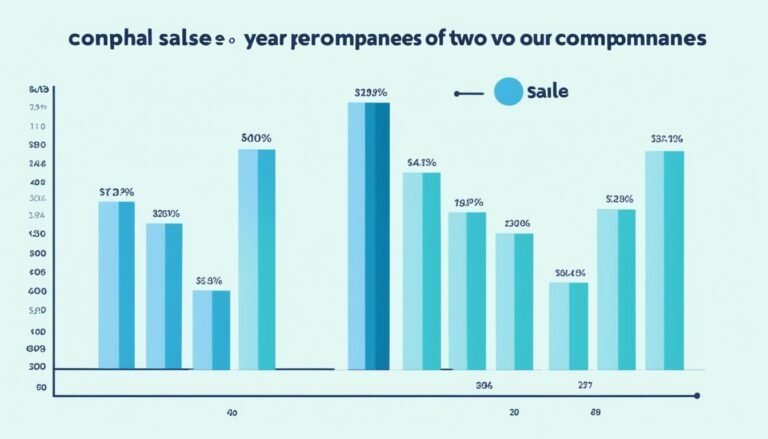Nonverbal Communication: Boost Your Sales Impact
Nonverbal communication is a powerful tool that can significantly impact your sales success. When it comes to sales, it’s not just about what you say but also how you say it. Your body language, facial expressions, and tone of voice all play a crucial role in conveying confidence, establishing rapport, and building trust with your clients.
In this article, we will explore the key aspects of nonverbal communication in sales and provide you with practical techniques and strategies to enhance your nonverbal communication skills for greater sales effectiveness. From mastering body language and facial expressions to leveraging tone of voice and active listening, we will cover it all to help you become a more persuasive and impactful sales professional.
Key Takeaways:
- Nonverbal cues can have a significant impact on your sales performance.
- Body language, facial expressions, and tone of voice all contribute to effective nonverbal communication in sales.
- Active listening and interpreting nonverbal cues can enhance your understanding of the client’s needs.
- Nonverbal communication is crucial in both in-person and virtual sales interactions.
- Continuously improving your nonverbal communication skills can lead to greater sales success.
The Importance of Body Language in Sales
When it comes to sales, effective nonverbal communication can make all the difference. Body language, comprising gestures, postures, and movements, plays a crucial role in establishing trust, building rapport, and conveying confidence and enthusiasm to potential clients. By mastering body language techniques, sales professionals can enhance their sales success and create lasting connections with customers.
One of the key aspects of body language in sales is using open palm gestures. Open palms are seen as non-threatening and convey honesty and openness. By incorporating open palm gestures during conversations or presentations, sales professionals can instantly build trust and put their clients at ease.
Additionally, maintaining good posture is essential for projecting confidence. Slouching or leaning back can give the impression of disinterest or lack of engagement. On the other hand, standing tall with shoulders back and maintaining an attentive posture shows that the sales professional is actively listening and genuinely interested in the client’s needs.
Furthermore, it’s important for sales professionals to avoid nervous behaviors like fidgeting or excessive hand movements. These actions can create a sense of distraction and undermine credibility. Instead, they should aim for smooth and purposeful movements that convey self-assurance and professionalism.
Using body language to build trust in sales is a powerful technique. When clients perceive sales professionals as confident and trustworthy, they are more likely to feel comfortable and develop a positive impression of the brand or product being offered.
“Body language is a universal language that everyone understands. Mastering it enables sales professionals to effectively connect and communicate with clients, ultimately boosting their sales impact.”
Key Body Language Techniques for Sales Success:
- Use open palm gestures to convey honesty and transparency.
- Maintain good posture to project confidence and engagement.
- Avoid nervous behaviors such as fidgeting or excessive hand movements.
- Exhibit purposeful and smooth movements that demonstrate professionalism.
By incorporating these body language techniques into their sales approach, professionals can create a powerful and positive impact on their clients, fostering trust and building long-lasting relationships.
| Benefits of Effective Body Language in Sales | How to Achieve It |
|---|---|
| Increase trust and credibility | Practice open palm gestures and maintain good posture |
| Establish rapport with clients | Avoid nervous behaviors and exhibit purposeful movements |
| Convey confidence and professionalism | Master body language techniques and apply them consistently |
The Power of Facial Expression in Sales
When it comes to nonverbal communication in sales, facial expressions play a crucial role. Our facial expressions can convey a wide range of emotions and intentions, which can significantly impact our sales interactions. Understanding and harnessing the power of facial expressions can help sales professionals build trust, establish rapport, and ultimately close deals.
One important aspect of facial expression in sales is eye contact. Maintaining eye contact with clients during conversations demonstrates active listening and shows that you value their input. It also conveys trust and attention, making clients feel heard and understood. By using eye contact effectively, you can establish a stronger connection with your clients and leave a lasting positive impression.
Another key facial expression in sales is smiling. A genuine smile can go a long way in building rapport with clients. Smiling conveys warmth, friendliness, and approachability, creating a welcoming and pleasant atmosphere during sales interactions. When clients feel comfortable and at ease, they are more likely to open up, ask questions, and be receptive to your sales pitch.
Nodding while listening to the client is another facial expression that shows interest and understanding. It demonstrates that you are actively engaged in the conversation and value what the client has to say. Nodding can also serve as a subtle form of encouragement, encouraging clients to continue sharing their thoughts and concerns. By nodding, you create a positive and receptive environment that promotes effective communication.
In addition to using facial expressions, sales professionals should also be aware of mirroring their client’s facial expressions. Mirroring involves subtly imitating the client’s facial expressions, such as their smile or frown. This technique can help in establishing rapport and building a connection with clients. Mirroring creates a sense of familiarity and similarity, making clients feel more comfortable with you and increasing their trust in the sales process.
Overall, facial expressions hold great power in the world of sales. By using eye contact, smiling, nodding, and mirroring, sales professionals can enhance their communication, establish trust, and strengthen their sales impact. Mastering facial expressions as a part of your nonverbal communication toolkit can make a significant difference in your sales success.
The Role of Eye Contact in Sales
Eye contact is a fundamental aspect of nonverbal communication in sales. It conveys trust, attention, and engagement, forming a crucial connection between sales professionals and clients. When you maintain eye contact with your clients, it demonstrates your active listening and genuine interest in what they have to say. It portrays your sincerity and professionalism, making clients feel valued and respected. Eye contact builds a foundation of trust, paving the way for successful sales interactions.
The Impact of Smiling in Sales
Smiling is a powerful facial expression that can significantly impact sales interactions. A genuine smile conveys warmth, friendliness, and positivity. When sales professionals smile, they create a welcoming and inviting environment for clients, making them feel more comfortable and open to engagement. Smiling also helps to build rapport and establish a connection, ultimately increasing the likelihood of successful sales outcomes.
Mirroring Facial Expressions to Build Rapport
Mirroring is a technique that involves subtly imitating the facial expressions of the other person. In sales, mirroring the client’s facial expressions can help establish rapport and create a sense of connection. By mirroring their smiles, frowns, or other expressions, you create a sense of familiarity and similarity, allowing clients to feel more comfortable and trusting. Mirroring facial expressions enhances communication and strengthens the relationship between sales professionals and clients.
The Impact of Tone of Voice in Sales
While not technically nonverbal, tone of voice plays a significant role in sales communication. A monotonous voice can be uninspiring, while an overly enthusiastic voice may come across as insincere. Sales professionals should aim to speak with passion, enthusiasm, and confidence, using clear and engaging speech. It’s important to practice voice skills and seek feedback to improve communication effectiveness.
“A well-modulated voice can make a world of difference in sales. It conveys professionalism, authority, and credibility. The way we speak can influence how our message is received and interpreted by clients.”
– Sarah Johnson, Sales Coach
Sales professionals should pay attention to the following factors to better utilize their tone of voice:
1. Speaking Clearly
Articulate your words clearly and enunciate each syllable. Avoid speaking too quickly and use pauses strategically to emphasize key points. Clarity in speech helps to convey professionalism and ensures that your message is easily comprehensible to the clients.
2. Inflection in Sales Presentations
Use appropriate inflection and intonation in your voice to emphasize important points and maintain the listener’s engagement. Vary your pitch and tone to avoid sounding monotonous and to convey enthusiasm and genuine interest in the conversation.
3. Practicing Voice Skills for Sales Success
Regularly practice vocal exercises and techniques to improve your voice modulation and control. Work on breathing techniques, vocal warm-ups, and pitch exercises to enhance your vocal delivery. Recording and listening to your own voice can help identify areas for improvement and ensure consistent progress.
Insights at a Glance
| Tone of Voice Tips | Benefits |
|---|---|
| Speak with passion and enthusiasm | Engage and inspire clients |
| Use clear and engaging speech | Convey professionalism and credibility |
| Vary inflection and intonation | Maintain listener’s engagement |
| Practice voice skills regularly | Improve vocal modulation and control |
By paying attention to their tone of voice, sales professionals can effectively convey confidence, enthusiasm, and trustworthiness, which are essential for building successful client relationships and closing deals. Developing and honing voice skills is an ongoing process that can significantly enhance sales communication and ultimately contribute to sales success.
Active Listening and Nonverbal Cues in Sales
Active listening is a critical skill in sales, allowing sales professionals to truly understand the needs and concerns of their clients. By actively engaging in the conversation and demonstrating empathy, sales professionals can build stronger relationships and increase their sales effectiveness. Nonverbal cues play a crucial role in enhancing active listening and conveying empathy in sales interactions.
Using Nonverbal Cues to Enhance Active Listening
Nonverbal cues can significantly enhance active listening in sales. Sales professionals should utilize specific nonverbal behaviors to show their attentiveness and engagement during conversations. Nodding, maintaining eye contact, and leaning forward are powerful nonverbal cues that indicate interest and understanding.
“Active listening requires more than just hearing words; it’s about understanding the unspoken messages conveyed through nonverbal cues.”
These nonverbal cues demonstrate that the sales professional is fully present and actively processing the information provided by the client. Such behaviors generate a sense of trust and rapport, making the client feel valued and understood.
Interpreting Nonverbal Cues in Sales
Interpreting nonverbal cues is an essential aspect of active listening in sales. By paying close attention to the client’s body language, facial expressions, and tone of voice, sales professionals can gather valuable insights into the client’s emotions, preferences, and level of interest.
For example, a furrowed brow or crossed arms may indicate skepticism or resistance, while a relaxed posture and open gestures may show receptiveness. By accurately interpreting these nonverbal cues, sales professionals can tailor their approach and response to better address the client’s needs and concerns.
Demonstrating Empathy Through Nonverbal Communication in Sales
Nonverbal communication is a powerful tool for demonstrating empathy in sales. Sales professionals should use nonverbal cues to convey that they understand and share the client’s emotions. This can be achieved through mirroring the client’s body language, facial expressions, and tone of voice.
When done subtly and authentically, mirroring helps build rapport and fosters a sense of connection between the sales professional and the client. It shows that the sales professional is genuinely engaged and empathetic, promoting a stronger relationship and increasing the likelihood of a successful sale.
| Nonverbal Cue | Meaning |
|---|---|
| Nodding | Indicates understanding and agreement |
| Maintaining eye contact | Shows attentiveness and focus |
| Leaning forward | Expresses interest and engagement |
| Mirroring body language | Builds rapport and connection |
By integrating active listening techniques with nonverbal cues, sales professionals can create a more meaningful and impactful sales experience. Understanding the importance of nonverbal communication in sales and mastering the ability to interpret and utilize nonverbal cues will take sales professionals’ performance to the next level.
Reading and Responding to Nonverbal Signals in Sales Negotiations
Nonverbal signals play a crucial role in sales negotiations, providing valuable insights into the client’s reactions and intentions. As a sales professional, it is essential to be attentive to these cues and use them to navigate negotiations effectively.
During sales negotiations, nonverbal signals can be observed in various aspects of the client’s body language, including facial expressions, arm movements, hand gestures, leg positions, and body angle. These signals can reveal the client’s attitude, engagement level, and even hidden emotions.
To interpret these nonverbal cues accurately, it is important to consider the context and observe patterns rather than relying on single gestures or expressions. For example, a furrowed brow might indicate concern or disagreement, while crossed arms can suggest defensiveness or resistance. By analyzing a combination of nonverbal signals, you can gain a more comprehensive understanding of the client’s thoughts and feelings.
Once you have read and interpreted the nonverbal signals, it is crucial to respond appropriately. By leveraging nonverbal signals, you can develop rapport, establish trust, and guide the negotiation process.
“Understanding body language is a powerful tool in sales negotiations. It allows you to identify and address any concerns or objections the client may have, leading to more successful outcomes.”
In order to respond effectively, consider these tips:
- Adapt your own body language to match the client’s. Mirroring their gestures and posture can establish a sense of rapport and create a comfortable atmosphere.
- Respond empathetically to the client’s nonverbal cues. If they exhibit signs of concern, address those concerns with understanding and reassurance.
- Adjust your tone of voice and speaking style to align with the client’s nonverbal cues. If they appear more formal and reserved, adopt a similar approach. If they seem more relaxed and casual, adopt a more conversational style.
- Use nonverbal signals to convey confidence, assertiveness, and credibility. A firm handshake, good eye contact, and a strong posture can make a positive impression and enhance your persuasive abilities.
When reading and responding to nonverbal signals in sales negotiations, it is important to remain adaptable and observant. Every client is unique, and their nonverbal cues may vary depending on their personality, culture, and individual preferences. By continually honing your skills in interpreting and leveraging nonverbal signals, you can elevate your sales negotiations and achieve greater success.
| Nonverbal Signals | Interpretation | Appropriate Response |
|---|---|---|
| Facial expressions | Reveal emotions and attitudes | Address concerns or objections, provide reassurance |
| Arm movements and hand gestures | Indicate engagement and emphasis | Facilitate active listening and respond accordingly |
| Leg positions and body angle | Suggest comfort level and openness | Adapt body language to establish rapport |
Mastering Nonverbal Communication in Video Call Sales
With the increasing prevalence of video call sales, mastering nonverbal communication in this format is crucial. Sales professionals need to adapt their nonverbal cues to effectively engage with clients through video calls. The virtual medium presents unique challenges, but with awareness and practice, sales professionals can harness the power of nonverbal communication to build rapport and enhance their sales impact.
“In a video call, body language, gestures, and facial expressions become even more important as they are the primary means of communication,” says Emily Richards, a sales expert at XYZ Company. “Sales professionals should pay careful attention to how they present themselves visually to create a lasting impression on their clients.”
When participating in virtual sales meetings, sales professionals should be mindful of their body language. Sitting up straight with an open and relaxed posture conveys confidence and professionalism. It’s important to maintain good eye contact by looking directly into the camera, rather than at the screen or other distractions. This creates a sense of connection and engagement with the client.

Gestures can also play a significant role in video call sales. Using natural and purposeful hand gestures can help emphasize key points and maintain the client’s attention. However, it’s essential to strike a balance; overly exaggerated or distracting gestures can detract from the sales message.
Facial expressions are equally crucial in video sales meetings. Sales professionals should project warmth and enthusiasm by smiling genuinely and nodding to show active listening and understanding. Additionally, mirroring the client’s facial expressions subtly helps establish rapport and creates a sense of connection.
“Virtual sales require sales professionals to be even more expressive with their facial expressions,” explains Sarah Thompson, a sales manager at ABC Corporation. “A warm and friendly smile can go a long way in building rapport and trust with clients.”
Managing the distance from the camera is another important aspect of nonverbal communication in video sales. Sitting too close can create discomfort, while sitting too far can make it difficult for the client to see facial expressions and gestures clearly. Sales professionals should position themselves at an appropriate distance to ensure visibility and maintain a professional appearance.
Effective Nonverbal Cues in Video Calls
Consider incorporating the following nonverbal cues to enhance your communication during video sales:
- Eye contact: Maintain eye contact with the camera to establish a strong connection with the client.
- Appropriate gestures: Use purposeful and natural gestures to emphasize key points and maintain client engagement.
- Facial expressions: Smile genuinely, nod, and mirror the client’s expressions to convey warmth and understanding.
- Proper distance: Sit at an appropriate distance from the camera to ensure visibility and a professional appearance.
| Nonverbal Communication Techniques | Benefits |
|---|---|
| Maintaining good eye contact | Creates a sense of trust and engagement with the client. |
| Using purposeful gestures | Enhances emphasis and maintains client attention. |
| Displaying genuine facial expressions | Builds rapport, warmth, and trust with clients. |
| Sitting at an appropriate distance from the camera | Ensures visibility and a professional appearance. |
Building a Strong Online Impression with Nonverbal Cues
In the digital age, creating a strong online impression is crucial for sales professionals. While nonverbal cues are traditionally associated with face-to-face interactions, they can also be effectively conveyed through online platforms such as LinkedIn and social media.
By leveraging digital body language and utilizing nonverbal signals in online interactions, sales professionals can create a positive digital presence that resonates with both clients and prospects. Here are some strategies for building a strong online impression:
- Create Authentic and Engaging Content: Share valuable insights, industry knowledge, and relevant updates to establish yourself as a thought leader. Authenticity is key in online interactions, so be genuine and true to your professional identity.
- Showcase Your Personality: Injecting your personality into your online presence helps create a connection with your audience. Share personal anecdotes, use humor, and engage in conversations that align with your core values.
- Align Digital Reputation with Company Values: Ensure that your online presence reflects the values and mission of your company. Consistency between your personal brand and your organization’s brand helps build trust and credibility.
- Engage in Meaningful Interactions: Actively participate in industry discussions, join relevant groups, and engage with your network by commenting, liking, and sharing their content. By demonstrating genuine interest in others, you contribute to a positive online community.
Remember, nonverbal cues are not confined to physical interactions; they transcend into the digital realm. By intentionally leveraging these cues in your online presence, you can make a lasting impression and establish meaningful connections with your online audience.
Just as your body language and facial expressions in face-to-face interactions convey important messages, your digital body language and nonverbal cues online can shape the way others perceive you. Building a positive online presence goes beyond a polished profile; it involves utilizing nonverbal signals to create a lasting impression in a virtual space.
Key Elements for a Strong Online Impression
| Element | Description |
|---|---|
| Authentic and Engaging Content | Share valuable insights and relevant updates to establish yourself as a thought leader. |
| Showcasing Personality | Inject your personality into your online presence to create a connection with your audience. |
| Alignment with Company Values | Ensure that your online presence reflects your organization’s values and mission. |
| Engaging in Meaningful Interactions | Actively participate in industry discussions and engage with your network to build relationships. |
The Art of Effective Hand Gestures in Sales
Hand gestures can be powerful tools for enhancing communication in sales. When used appropriately, hand gestures can complement and reinforce verbal messages, making sales presentations more impactful and memorable.
There are several types of hand gestures that sales professionals can employ to effectively convey their message:
- Open Palm Gestures: Open palm gestures, such as extending the hand with the palm facing up, can signify honesty, transparency, and a willingness to collaborate. This gesture helps build trust and establish a positive connection with clients.
- Illustrative Gestures: Sales professionals can use illustrative gestures to visually demonstrate concepts, ideas, and product features. These gestures help create a clearer mental image for the client, aiding their understanding and retention of information.
- Gestures of Confidence and Enthusiasm: Confident and enthusiastic hand gestures, such as a firm handshake or a strong fist pump, convey passion and excitement. These gestures can ignite the same emotions in clients, motivating them to take action and make a purchase.
It’s important to note that cultural differences may exist when it comes to hand gestures. Sales professionals should be mindful of these cultural nuances and adjust their gestures accordingly in cross-cultural sales interactions. Taking the time to learn about and respect different cultural norms will help avoid misunderstandings and build stronger relationships with clients from diverse backgrounds.
By mastering the art of effective hand gestures in sales, sales professionals can elevate their communication skills, engage clients on a deeper level, and increase the likelihood of achieving successful sales outcomes.
Examples of Matching Hand Gestures to Verbal Messages
| Verbal Message | Matching Hand Gesture |
|---|---|
| “We have a big opportunity!” | Spread arms wide to convey magnitude |
| “This product is a perfect fit for your needs.” | Bring hands together to symbolize fitting together |
| “Our solution is innovative and cutting-edge.” | Make a slicing motion with one hand |
| “We will work together as a team.” | Clasp hands together to demonstrate unity |
Conclusion
Nonverbal communication is a critical aspect of successful sales interactions. From pitches to negotiations and client interactions, the importance of nonverbal cues in sales cannot be overstated. Sales professionals must be mindful of their body language, facial expressions, and tone of voice, as these elements play a significant role in conveying confidence, warmth, and enthusiasm.
Integrating nonverbal communication skills is paramount in boosting sales impact. By continuously refining and improving these skills, sales professionals can enhance their ability to establish rapport, build trust, and effectively communicate with clients. The ongoing improvement of nonverbal communication in sales is an ongoing process that requires dedication and practice, but the rewards can be substantial.
In conclusion, mastering nonverbal communication is a key element in achieving success in sales. By harnessing the power of body language, facial expressions, and tone of voice, sales professionals can create meaningful connections, effectively convey their messages, and ultimately drive sales results. Embracing nonverbal cues and continually enhancing nonverbal communication skills is a worthwhile investment that can take sales performance to new heights.







